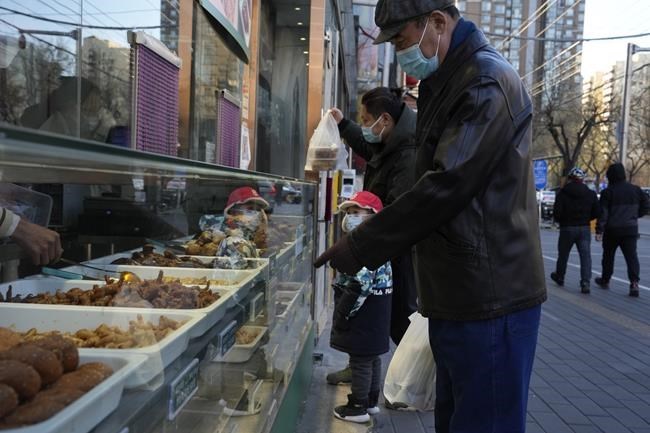HONG KONG (AP) — China on Sunday reported two additional deaths from COVID-19 as some cities move cautiously to ease anti-pandemic restrictions amid increasingly vocal public frustration over the measures.
The National Health Commission said one death was reported each in the provinces of Shandong and Sichuan. No information was given about the ages of the victims or whether they had been fully vaccinated.
China, where the virus first was detected in late 2019 in the central city of Wuhan, is the last major country trying to stop transmission completely through quarantines, lockdowns and mass testing. Concerns over vaccination rates are believed to figure prominently in the ruling Communist Party’s determination to stick to its hardline strategy.
While nine in 10 Chinese have been vaccinated, only 66% of people over 80 have gotten one shot, while 40% have received a booster, according to the commission. It said 86% of people over 60 are vaccinated.
Given those figures and the fact that relatively few Chinese have been built up antibodies by being exposed to the virus, some fear millions could die if restrictions were lifted entirely.
Yet, an outpouring of public anger appears to have prompted authorities to lift some of the more onerous restrictions, even as they say the “zero-COVID” strategy — which aims to isolate every infected person — is still in place.
Beijing and some other Chinese cities have announced tthat riders can board buses and subways without a virus test for the first time in months.
The slight relaxation of testing requirements comes even as daily virus infections reach near-record highs, and follows weekend protests across the country by residents frustrated by the rigid enforcement of anti-virus restrictions that are now entering their fourth year, even as the rest of the world has opened up.
The southern technological manufacturing center of Shenzhen said Saturday that commuters no longer need to show a negative COVID-19 test result to use public transport or when entering pharmacies, parks and tourist attractions.
Meanwhile, the capital Beijing said Friday that negative test results are also no longer required for public transport from Monday. However, a negative result obtained within the past 48 hours is still required to enter venues like shopping malls, which have gradually reopened with many restaurants and eateries providing takeout services.
The requirement has led to complaints from some Beijing residents that even though the city has shut many testing stations, most public venues still require COVID-19 tests.
On Sunday, China announced another 35,775 cases from the past 24 hours, 31,607 of which were asymptomatic, bringing its total to 336,165 with 5,235 deaths.
While many have questioned the accuracy of the Chinese figures, they remain relatively low compared to the U.S. and other nations which are now relaxing controls and trying to live with the virus that has killed at least 6.6 million people worldwide and sickened almost 650 million.
On Saturday, Beijing authorities said that because the current round of COVID-19 was spreading fast, it is necessary to “unswervingly continue to implement normalized social prevention and control measures."
As the rest of the world has learned to live with the virus, China remains the only major nation still sticking to a “zero-COVID” strategy. The policy, which has been in place since the pandemic started, led to snap lockdowns and mass testing across the country.
China still imposes mandatory quarantine for incoming travelers even as its infection numbers are low compared to its 1.4 billion population.
The recent demonstrations, the largest and most widely spread in decades, erupted Nov. 25 after a fire in an apartment building in the northwestern city of Urumqi killed at least 10 people.
That set off angry questions online about whether firefighters or victims trying to escape were blocked by locked doors or other anti-virus controls. Authorities denied that, but the deaths became a focus of public frustration.
The country saw several days of protests across cities including Shanghai and Beijing, with protesters demanding an easing of COVID-19 curbs. Some demanded Chinese President Xi Jinping step down, an extraordinary show of public dissent in a society over which the ruling Communist Party exercises near total control.
Xi’s government has promised to reduce the cost and disruption of controls but says it will stick with “zero COVID.” Health experts and economists expect it to stay in place at least until mid-2023 and possibly into 2024 while millions of older people are vaccinated in preparation for lifting controls that keep most visitors out of China.
While the government has conceded some mistakes, blamed mainly on overzealous officials, public figures, business people, ordinary citizens and even athletes have been punished for criticizing government policies. Former NBA star Jeremy Lin, who plays for a Chinese team, was recently fined 10,000 yuan ($1,400) for criticizing conditions in team quarantine facilities, according to local media reports.
On Friday, World Health Organization emergencies director Dr. Michael Ryan said that the U.N. agency was “pleased” to see China loosening some of its coronavirus restrictions, saying “it’s really important that governments listen to their people when the people are in pain.”
Zen Soo, The Associated Press


